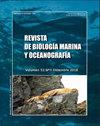Variación interanual en la dieta invernal del flamenco chileno Phoenicopterus chilensis (Aves: Phoenicopteriformes) en el humedal marino de Bahía Caulín, Chiloé, sur de Chile
IF 0.5
4区 生物学
Q4 MARINE & FRESHWATER BIOLOGY
引用次数: 5
Abstract
espanolEl flamenco chileno (Phoenicopterus chilensis) es un ave acuatica endemica de America del Sur. En Chile habita tanto en lagunas altiplanicas como en humedales marinos. Sin embargo, los estudios dietarios en ambientes marinos son escasos. En este trabajo se caracterizo la variacion interanual en la dieta invernal del flamenco en el humedal marino de Bahia Caulin, sur de Chile. Para ello, se determino el tamano de las presas entre junio a septiembre del 2011, 2014 y 2015. Se analizo un total de 157 heces (77 heces en 2011 y 80 heces entre 2014 y 2015). La dieta del flamenco chileno durante el 2011 fue carnivora y estuvo conformada solo por tres presas: el foraminifero Ammonia beccarii, el copepodo Harpacticus sp. y poliquetos. Durante 2014-2015 su dieta fue omnivora, incluyendo la presencia de 15 categorias de presas, entre las que destaco el consumo de algas y fibras vegetales. En lo que respecta a los tamanos de las presas consumidas por el flamenco, el diametro de los foraminiferos oscilo entre los 100 y 900 µm con predominio de organismos entre los 400 y 600 µm. El ancho de Harpacticus sp. consumidos oscilo entre los 160 y 260 µm con predominio para los organismos entre los 200 y 220 µm. El ancho de Parawaldeckia kidderi consumidos oscilo entre los 140 y 800 µm con predominio para los organismos entre los 140 y 400 µm. El ancho de Monocorophium insidiosum consumidos oscilo entre los 80 y 500 µm con predominio para los organismos entre los 80 y 400 µm. El flamenco chileno seria un depredador parcialmente selectivo cuya seleccion de presas estaria dada por las restricciones morfoestructurales del pico de esta ave. EnglishThe Chilean flamingo (Phoenicopterus chilensis) is an endemic aquatic bird of South America. In Chile, it is found in both highland lagoons as well as in marine wetlands. Nevertheless, dietary studies in marine environments are scarce. This work characterized the interannual variation in the winter diet of flamingos found in the marine wetland of Bahia Caulin, southern Chile. To this end, we determined the size of prey items consumed between June and September of the 2011, 2014 and 2015. A total of 157 feces were analyzed (77 feces in 2011 and 80 feces between 2014 and 2015). The diet of Chilean flamingo during 2011 was carnivorous and was formed by only three preys, the foraminifera Ammonia beccarii, the copepod Harpacticus sp. as well as polychaetes. During 2014-2015 its diet was omnivorous, and consisted of 15 categories of prey items, among which the consumption of algae and plant fibers was stressed. Regarding the sizes of prey consumed by flamingo, the diameter of the foraminifera oscillated between 100 and 900 µm with predominance of organisms between 400 and 600 µm. The width of Harpacticus sp. consumed ranged from 160 to 260 µm with a predominance of organisms between 200 and 220 µm. The width of consumed Parawaldeckia kidderi ranged between 140 and 800 µm with predominance for organisms between 140 and 400 µm. The width of Monocorophium insidiosum consumed oscillated between 80 and 500 µm with predominance for organisms between 80 and 400 µm. The Chilean flamingo would be a partially selective predator whose selection of prey would be given by the morphostructural restrictions of the peak of this bird.智利南部巴伊亚caulin海洋湿地智利火烈鸟Phoenicopterus chilensis(鸟类:Phoenicopteriformes)冬季饮食的年代性变化,chiloe
智利火烈鸟(Phoenicopterus chilensis)是一种原产于南美的特有水鸟。在智利,它生活在高原泻湖和海洋湿地中。然而,海洋环境中的饮食研究很少。本文描述了智利南部Bahia Caulin海洋湿地弗拉门戈冬季饮食的年际变化。为此,确定了2011年6月至9月、2014年至2015年期间的大坝尺寸。共分析了157种粪便(2011年为77种,2014年至2015年为80种)。2011年,智利弗拉门戈的饮食是食肉动物,只有三种猎物:有孔虫Ammonia Beccarii、桡足类Harpacticus sp.和多毛类动物。在2014-2015年期间,他的饮食是杂食性的,包括15类猎物的存在,其中最突出的是藻类和植物纤维的消费。至于弗拉门戈人消耗的猎物的大小,有孔虫的直径在100至900µm之间,以400至600µm的生物为主。消耗的Harpacticus sp.的宽度在160至260µm之间,生物的主要宽度在200至220µm之间。消费的Paraldeckia kidderi的宽度在140至800µm之间,生物的主要宽度在140至400µm之间。消耗的阴险单核菌的宽度在80至500µm之间,生物的主要宽度在80至400µm之间。智利火烈鸟将是一种部分选择性的捕食者,其猎物的选择将取决于这种鸟喙的形态结构限制。英语智利火烈鸟(Phoenicopterus chilensis)是南美特有的水鸟。在智利,它既存在于高地泻湖中,也存在于海洋湿地中。然而,海洋环境中的饮食研究很少。这项工作的特点是在智利南部Bahia Caulin海洋湿地发现的火烈鸟冬季饮食的年际变化。为此,我们确定了2011年6月至9月、2014年至2015年期间消费的猎物数量。共分析了157个日期(2011年为77个日期,2014年至2015年为80个日期)。2011年,智利火烈鸟的饮食是食肉的,只有三只猎物组成,即有孔虫Ammonia Beccarii、桡足类Harpacticus sp.以及多毛类动物。2014-2015年期间,它的饮食是杂食性的,由15类猎物组成,其中藻类和植物纤维的消费受到强调。关于火烈鸟食用的猎物的大小,有孔虫的直径在100至900µm之间,以有机物为主,在400至600µm之间。食用的Harpacticus sp.的宽度在160至260µm之间,以200至220µm的生物体为主。食用的Paraldeckia kidderi的宽度在140至800µm之间,以140至400µm的生物体为主。消费的阴险单冠状病毒的宽度在80至500µm之间,以80至400µm的生物体为主。智利火烈鸟将是一种部分选择性的捕食者,其捕食者的选择将受到这种鸟喙的形态结构限制。
本文章由计算机程序翻译,如有差异,请以英文原文为准。
求助全文
约1分钟内获得全文
求助全文
来源期刊
CiteScore
0.70
自引率
0.00%
发文量
41
审稿时长
12 months
期刊介绍:
Publicar desde una perspectiva científica, artículos originales, decididos por un proceso de revisión por pares, invitando a expertos de reconocido prestigio en el área. Los trabajos publicados se caracterizarán por su solidez teórica-metodológica, actualidad y relevancia para las ciencias marinas.
Se reciben trabajos inéditos derivados de la investigación científica realizada en ambientes marinos y estuarios, en formato de Revisión, Artículos, Notas Científicas, y Obituarios en las siguientes disciplinas::
Biología-Ecología marina
Oceanografía física, química y biológica
Contaminación marina
Geología marina
Sistemática, Faunística y Biogeografía Marina
Manejo Costero
Acuicultura marina
Pesquería marina.

 求助内容:
求助内容: 应助结果提醒方式:
应助结果提醒方式:


